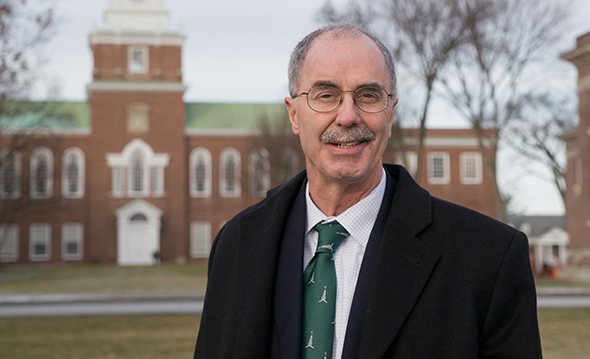Friday, January 11th marked the first public appearance of Dr. Phil Hanlon ’77 as President-Elect of Dartmouth College. After brief introductions by Interim President Folt and Trustee Board Chairman Steve Mandel ’78, Dr. Hanlon spoke of his experiences at the College, drawing comparisons between present-day Dartmouth and the school presided over by President Kemeny in the 1970s.
It makes sense that Dr. Hanlon would invoke President Kemeny, who presided over both coeducation and the insti- tution of the D-plan. Kemeny was president throughout Dr. Hanlon’s undergraduate years. Similarities exist between the two beyond their penchant for numbers and fashionable facial hair.
For instance, Dr. Hanlon’s speech highlighted the importance of undergraduate research, a sentiment that led Kemeny (who was himself a research assistant to Albert Einstein at Princeton) to pioneer the field of computing on the Dartmouth campus.
John Kemeny’s connection to computing was perhaps the most interesting aspect of his long rela- tionship with Dartmouth College. When he joined the faculty in 1953, the closest computer was at MIT. Kemeny made the 135-mile commute frequently until Dartmouth got its own computer six years later. He oversaw use of the LGP-30 by undergraduate students, encouraging their exposure to the new technology.
Kemeney’s enthusiasm was matched by Thomas Kurtz, also of the Dartmouth math department. The two partnered not only in their personal research, but also in the promotion of computing as a research tool for undergraduates. “We at Dartmouth envisaged the possibility of millions of people writing their own computer programs,” Kemeny wrote. To that effect, Kemeny and Kurtz invented the Dartmouth Time Sharing System, which greatly improved computer efficiency and allowed for multiple users access to a CPU from individual terminals. They also invented BASIC in 1964 as an effective, but accesible coding language.
When Kemeny assumed the presidency of Dartmouth in 1971, his perspective evolved. Computers were more than academic tools, they were fast becoming an integral part of society and a subject worth under- standing by virtue of itself. Kemeny wrote, “While computers alone cannot solve the problems of society, these problems are too complex to be solved without highly sophisticated use of computers.” It was crucial, he held, to promote a computer-literate society. President Kemeny not only identified the crucial role computers would play in all aspects of society, but took that intuition and co-opted it into a part of the Dartmouth education.
That point brings us at last to Dr. Hanlon’s speech on January 11th, in which he identified globalization as the newest trend Dartmouth College must address. As he told the audience in Spaulding Auditorium, “our graduates are entering a workplace that is itself undergoing profound changes, a work environment that is characterized by increasing levels of volatility, complexity, workplace diversity, and global reach.” Dr. Hanlon has only begun to step into his role as head of the College, but already his mindset resembles that of President Kemeny, identi- fying the larger trends that will in all likelihood come to characterize the professional ex- perience of Dartmouth graduates. Dr. Hanlon has already embraced the presidency, and while it may be too early to draw substantive conclusions about his leadership, it is clear that he is already thinking like a college president.
Dr. Hanlon further stated that Dartmouth’s primary task is to develop students into leaders that understand and shape the global conversation. His speech did not describe the Dartmouth envisioned by Dr. Kim, but the school that provides the best education to its students. To that end, his stated intention to teach undergraduates courses in the math department is significant, as it bolsters the strength of his commitment to the fundamentals of the Dartmouth education.
The importance Dr. Hanon places on leadership also denotes an appreciation for the ducation gleaned both inside and out of the classroom. Given that he is inheriting a role with an impetus to address student life concerns–which, to wit, encompass not only the Greek system but all campus organizations including athletics–such appreciation could prove meaningful when Dr. Hanlon invariably addresses the College’s insuffererable current policies.
Utimately Dr. Hanlon’s agenda based solely on his initial remarks proves a limited excersize. More constructive, perhaps, is the agenda offered here by the writers of The Dartmouth Review, who assert that tsuch changes will go a long way toward improving the College and her vital organs.


Be the first to comment on "Kemeny, Hanlon, Computers & The World"